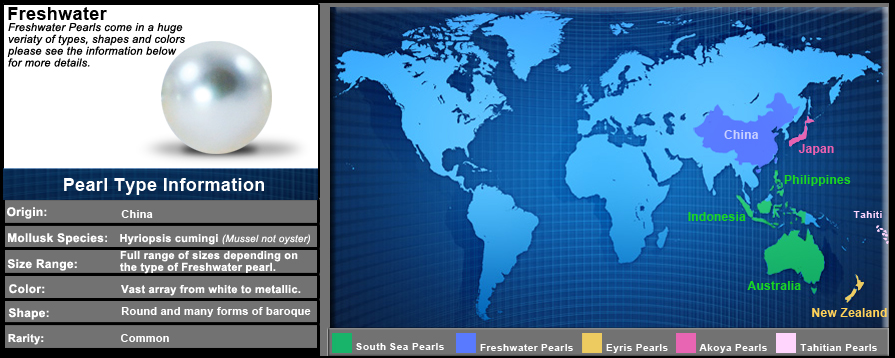WHAT MAKES THEM DIFFERENT?
There are many factors that set the freshwater variety of pearl apart from the saltwater. The first factor is that freshwater pearls are grown in lakes and ponds around mainland China, where as the saltwater pearls are grown in oceans. The second factor that differentiates freshwater pearls from the other varieties is the actual mollusk that produces the pearls. Saltwater pearls are produced by oysters; freshwater pearls are produced by mussels. The mussels that grow freshwater pearls are extremely durable and are capable of producing pearls in much harsher conditions that that of saltwater oysters. Although there are many differences between these varieties nothing may separate them more than the fact that one freshwater mussel can produce up to 40 pearls in just one harvest where as saltwater oysters can produce just one |
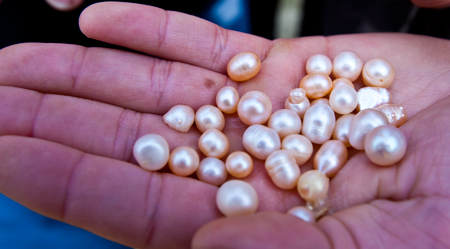 The image above shows the pearls harvested from just one mussel. As you can see none of the pearls are round which is why round pearls are still somewhat rare in the freshwater categories. The image above shows the pearls harvested from just one mussel. As you can see none of the pearls are round which is why round pearls are still somewhat rare in the freshwater categories. |
THE OPERATION
The nucleation process used in freshwater pearls differs from that employed in saltwater pearl production. In freshwater cultured pearls only a piece of mantle tissue from a donor mussel is used for the nucleus which is then implanted into the mantle area of a six to seven month old mussel. In saltwater cultured pearls, a piece of mantle tissue from a donor oyster along with a bead nucleus is implanted in the gonad area of the oyster. The mantle pieces used in Freshwater nucleation are cut into rectangular pieces and as many as forty to fifty pieces are placed in a mussel. This compares to the one or two nuclei used in cultivating saltwater pearls. This helps you understand why there is so much overproduction in freshwater pearls. A result of using a rectangular piece of mantle for the nucleus is that a very small percentage of the pearls produced, around three percent are round. Approximately eighty-five percent round pearls are produced in saltwater cultivation. The difference being that in saltwater production a round bead nucleus is inserted along with the mantle piece. |
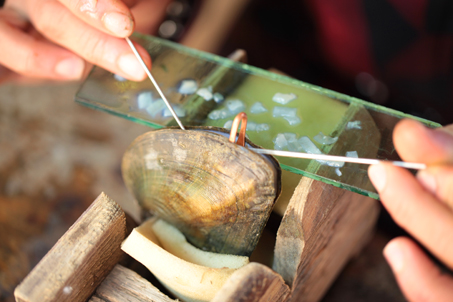 This image depicts the nucleation of a freshwater pearl mussel. The small white objects on the glass are pieces of tissue that are cut and implanted. Judging by the size of the oyster it is a baby and this is the first grafting (operation). After the pearls are harvested it will be re grafted up to about 4 or 5 times producing larger pearls each time, due to the growth and expansion of the original pearl sacks This image depicts the nucleation of a freshwater pearl mussel. The small white objects on the glass are pieces of tissue that are cut and implanted. Judging by the size of the oyster it is a baby and this is the first grafting (operation). After the pearls are harvested it will be re grafted up to about 4 or 5 times producing larger pearls each time, due to the growth and expansion of the original pearl sacks |
The most commonly used mussel known, as the Hyriopsis cumingi is capable of producing up to 40 pearls each harvest. This is a huge difference than that of saltwater oysters which can only produce one pearl at a time. The reason that the Hyriopsis cumingi can produce this large quantity is because they do not produce their pearls in the gonad, instead they are produced in the mantle tissue. The mantle tissue is the tissue coating the inner valves of the mussel and when an irritant is implanted under this tissue a pearl sack is created and nacre begins to be deposited. Due to the amount of tissue coating the inner shell multiple irritants can be implanted resulting in a large quantity of pearls.
A very large percentage of freshwater pearls that are produced today are grown in China. Serious production started in the 1970’s and the Chinese learned a lesson about the international pearl market very quickly, the market cares more about quality than it does about quantity. Because it was so easy to cultivate poor quality freshwater pearls many Chinese stopped working at other jobs and took up mussel growing. One could literally dig out an area in his yard, fill it with water, add nutrients to the water and start to cultivate freshwater mussels and either sell the mussels to someone else for cultivation purposes or start your own pearl cultivation. This unregulated growth resulted in many peoples first reaction to freshwater pearls as if they looked like “Rice Krispies”. Since these early beginnings the Chinese have made many changes. |
 The image above features the inside of a hyriopsis cumingi that is fully matured. The actual animal as you can see is not in the shell but please notice the amazing coloration. Some of the metallic colored pearls that we find in the market today come from this colorful area ib the high rim of the shell. (This actual shell produced the soufflé pearls featured in the image below) The image above features the inside of a hyriopsis cumingi that is fully matured. The actual animal as you can see is not in the shell but please notice the amazing coloration. Some of the metallic colored pearls that we find in the market today come from this colorful area ib the high rim of the shell. (This actual shell produced the soufflé pearls featured in the image below) |
most importantly, they have changed the mussel used to cultivate the pearls. Originally, Cristaria plicata mussels were used because they allowed for a quicker pearl growth time. Now, Hyriopsis cumingi mussels are used because the quality of the pearls they produce is much better that the faster growing Cristaria plicata. While production is still not regulated, the cultivators are taking more care to see that the water the pearls are grown in stays relatively clean and the areas picked for production are not too adversely affected by weather conditions.
After the nucleation operation is performed the mussels are returned to the water to recuperate and are suspended two or three feet in the water from nets. The mussels can stay in the water from two to six years. What happens most of the time is that the mussels are kept in the water for approximately two years and then they are removed and the pearls harvested. Those mussels that produced the better quality pearls are again put back in the water for another two to three years. After being harvested, the pearls are then bleached to whiten them and then they go through a polishing process. In the case of unusual colored pearls, they are not bleached, only polished. The pearls are then sorted and separated into different qualities. Those pearls to be used for necklaces are drilled thru and those selected for jewelry are half-drilled. The top quality pearls are not drilled but rather sold as individual pearls in lots. The majority of the pearls are sold to processors and manufacturers in Hong Kong.
WHAT DOES THE FUTURE HOLD?
Today freshwater pearls may be the most exciting pearl type on the market. Every year the farmers experiment with their techniques which constantly result in new and evolving types of pearls. This can be done because the freshwater mussel is so much more durable and is less likely to reject the implanted nucleus. Soufflé pearls are a perfect example of these experimental techniques. Soufflé pearls are large pearls that are very light in weight; they are the newest pearls that have come from China. They are formed by a farmer inserting an organic earthen substance under the mantle tissue of the mussel into a pre existing pearl sack. The pearls form around the earthen material over the next few years. After the pearl is done growing it is removed from the mussel and drilled. Once these pearls are drilled the earthen substance can be removed and you are left with a large pearl that is hollow inside. |
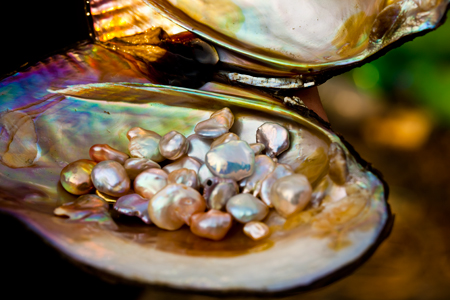 The pearls pictured above are soufflé pearls notice the large size and metallic color. The pearls pictured above are soufflé pearls notice the large size and metallic color. |
China has been trying to implant bead nuclei into the mantle tissue of their mussels for a very long time with little success. Typically what we have seen as a result of bead nucleation are known as fireball pearls. A fireball pearl is the result of the nacre being deposited not only over the bead but the incision as well creating the look of a tail or trail of fire coming from the pearl. With the development of technique and experimentation we are beginning to see the first successful round bead nucleated freshwater pearls which tend to come in beautiful metallic colors with absolutely outstanding luster as seen in the image to the right. |
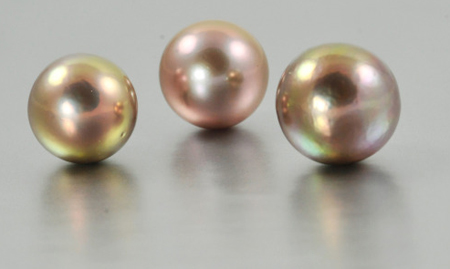 These pearls range in size from 12-14mm they are an example of where china stands right now as far as their new and improved larger bead nucleated pearls. Although these pearls have a slightly hammered surface they are absolutely gorgeous none the less. These pearls range in size from 12-14mm they are an example of where china stands right now as far as their new and improved larger bead nucleated pearls. Although these pearls have a slightly hammered surface they are absolutely gorgeous none the less.
|
 |
|
